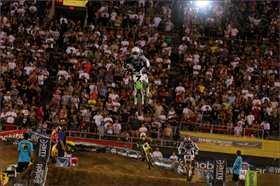Welcome to something we’re calling the Number Cruncher, brought to
you by Shift MX here at Racer X Online. I hope you will find this new
weekly feature highly entertaining, with its juxtaposition of
new-school and old-school flavors. I know a lot of you out there will
share my attachment to not only your own racing number, but also all
racing numbers in general. For instance, have you ever spotted the #259
on an exit sign or a mile marker and thought, Hey, that’s Bubba’s
number?
A number can be so much more than a means to differentiate competitors.
I know when I was a kid, my beloved #77 was very special to me. I would
always put my number beside my name at the top of my homework papers in
school; if I went to a local car race, I would root for the 77 ball.
Professional motocross used to use numbers as a ranking system, and
each off-season we’d wait to see who would earn what digit when the new
numbers came out, or we'd even go so far as to do the math ourselves,
adding up all of the points to figure out that Jeff Stanton would wear
#2 in 1993, the MX Kied was #3, the headed-to-road racing JMB earned
but never wore #4, and Mike LaRocco would wear #5 as a precursor of
things to come.
But then, six years ago, the AMA established its semi-permanent number
system (and Europe soon followed), modeled after other larger, more
popular and successful sports with a mindset for advantages in
marketing and rider/fan awareness. This system has worked very well for
almost every number out there. The idea was to have a constant number
work like the way the #23 did for Nike and Michael Jordan, or the good
old #3 for NASCAR and Dale Earnhardt’s legacy. The thinking was, the
riders could market themselves better if they didn’t switch numbers
every year like, say, Doug Henry, who until the permanent system was in
place, wore such digits as #19, #8, #16, #4, #15, #20, and even #1.
And that’s where the rub was: Ricky Carmichael earned the #1 ten times
since 2001 but only wore it for select events. And ’04 AMA Supercross
Champ Chad Reed never wore it, and the one time James Stewart did (Las
Vegas ’03 with the #1W), well, it ended badly. But that may change in
2007.
Last Saturday night, there were but three numbers on everyone’s minds:
RC’s #4, Reed’s #22, and the first number we’re going to serve up
through the Shift MX Number Cruncher, James Stewart’s #7. When James
decided he needed a change in his life and wanted start a “New
Beginning” and a new number other than the #259 he’s worn for his
entire pro career, he could not have chosen a number richer in heritage
and history. In fact, Lucky Number Seven may be one of the most
recognizable motocross numbers of all time, even though it’s been
mostly absent the last few years. The original bad boy of American
motocross, “Bad” Brad Lackey, wore that number as he chased the
Europeans around the 1972 Trans-AMA circuits on his Kawasaki, earning
“Top American” honors and a ticket to Europe to start racing the 500cc
Grand Prix circuit. Next came “Jammin’” Jimmy Weinert, who wore that
number into history in Charlie Morey’s motocross-work-of-art photo that
has won him acclaim since he shot it in 1974 in Ohio. We’ll pick up it
up with photos right there.
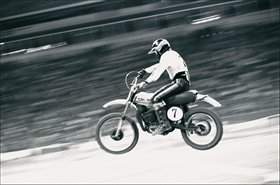 | | Jimmy Ellis | | photo courtesy of Moto Verte |
|
|
If
#7 is your number, you will be proud to know that the first man to wear
it to an AMA Supercross Championship was Jimmy Ellis. In 1975, the
Can-Am rider from Cobalt, Connecticut, swept all four rounds of the
supercross series' second year. But history does not recall this
four-race sweep as a perfect season, most likely because there just
weren’t enough races.
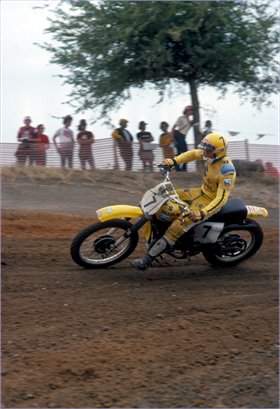 | | Danny LaPorte | | photo: Dick Miller Archives |
|
|
Danny
LaPorte wore #7 in his second year as a Suzuki factory rider, but he
didn’t have any luck with it. In fact, in what turns out to have been
the closest AMA National Championship battle ever, LaPorte lost the
125cc title to Broc Glover on a tiebreaker. Each had 240 points after
the last moto, but that moto saw runaway leader Bob Hannah “Let Brock
Bye” on the last lap, giving Glover the title on the tiebreaker.
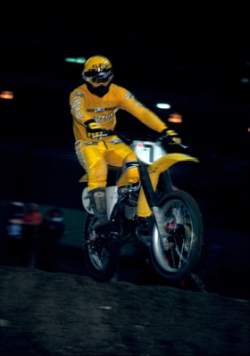 | | Marty Tripes | | photo: Dick Miller Archives |
|
|
Marty
Tripes was a notorious talent in the 1970s, and he wore #7 toward the
end of his career. He rode for the Honda, Bultaco, Can-Am, and
Husqvarna teams and so on and so forth. But Marty had some weight
issues that he never beat, and the end of his career was not as stellar
as the beginning, when he won the very first supercross in 1972 at age
16 years, 10 days – and that was the 250 class!
 | | Donnie Hansen | | photo: Dick Miller Archives |
|
|
The
next AMA Supercross Champion to wear Lucky Number 7 was Donnie
“Holeshot” Hansen. He won both indoors and out in his breakthrough 1982
season with Team Honda, but in September of that year, a crash while
practicing in Germany for the Motocross des Nations ended his career.
He only wore #1 once, in practice at an ’83 SX race, where he quickly
realized he was never going to be able to ride the same again.
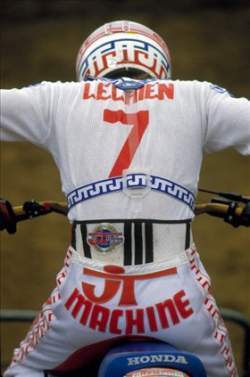 | | Ron Lechien | | photo courtesy of Moto Verte |
|
|
Ron
Lechien liked being called “Machine” in 1984, but he was really just
getting going on the “Dogger” persona that would ultimately be his
downfall. Lechien rode the 250 class in SX and MX that year and won a
single SX main (Oakland) and four 250 Nationals, but the title went to
his nemesis, Yamaha-mounted Ricky Johnson.
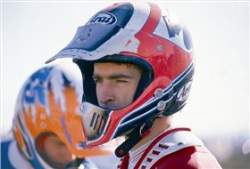 | | Jeff Stanton | | photo courtesy of Moto Verte |
|
|
After
seeing the #7 worn by George Holland and Jeff Leisk in the late 1980s,
Jeff Stanton took over in 1989 and, like Hansen, had a breakthrough
year. When Honda team captain Rick Johnson went down with a broken
wrist, Stanton stepped it up on the #7 CR250R and won both the AMA
Supercross title and the AMA 250 National Championship title – the
first of six titles he would win over the course of four amazing
seasons (’89 to ’92) before a former BMXer named Jeremy joined Team
Honda.
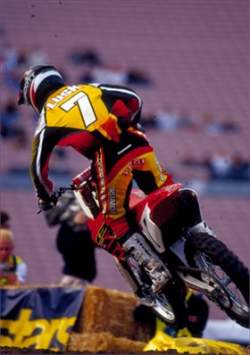 | | Ezra Lusk | | photo: Simon Cudby |
|
|
Popular
heroes Guy Cooper, Doug Dubach, and
Mike LaRocco would also run the #7
in the early 1990s, followed later on by
Kevin Windham and Ezra Lusk.
In fact, Lusk would wear the number in the last race of the last
millennium: the World Supercross race at the Rose Bowl in Pasedena, in
front of thousands of empty seats. But that didn’t stop “Yogi,” who won
the race going away.
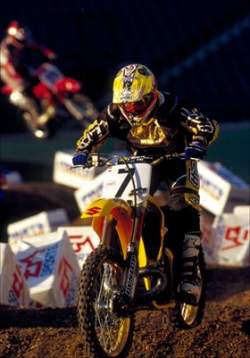 | | Greg Albertyn | | photo: Simon Cudby |
|
|
The
last man to spend quality time with #7 before December of 2005 was Greg
Albertyn, who snatched it up when the AMA went into its semi-permanent
system at almost the exact same time that Albertyn was retiring. He
wore it just a couple of times, and then it was mothballed until
someone else won a title and chose it, as it had been passed over to
that point by riders like Carmichael,
Travis Pastrana,
Mike Brown,
Grant Langston, and
Ivan Tedesco, who had won titles in recent years.
Finally,
searching for a new beginning,
James Stewart decided to forgo his own
trademarked #259 for a new-look #7. He started with three straight wins
in World Supercross and AMA Supercross (Anaheim 1) before he started
having some first-turn trouble and mid-race staying power. But as the
supercross season wound down, Stewart showed that he now owns this
number, winning the last six SX races of 2006 going away and taking the
2006 Amp’d Mobile World Supercross title from
Ricky Carmichael—the one
title, we must not forget, that Ricky failed to successfully defend.
Now James has a choice in 2007: Lucky Number 7 or an FIM #1. What will
he do? Guess we'll find out in Toronto come this December!
Got a number you want us to crunch?
Letters@racerxill.com.










